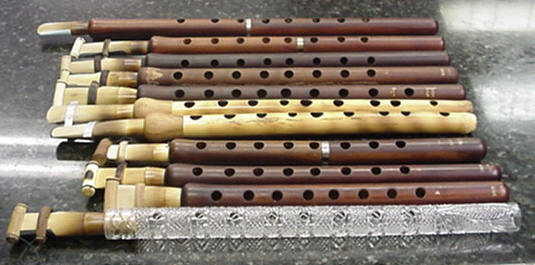| Click Here to Return to Woodwinds Home |
| Click Here to Return to Zangezur Home |
The Duduk (pronounced doo-dook) is considered the most "Armenian" of all folk instruments because of its Armenian origins and its ability to honestly express the emotions of the Armenian people. It has a 1500 year history and is native to Armenia although there are variants played in Turkey, Georgia, and Azerbaijan. The duduk reflects the passion, celebration, and suffering of Armenia. Aram Khatchadourian once said that the duduk is the only instrument that made him cry.
The soulful sound of the duduk has recently been in the World Music spotlight thanks to musical artist Peter Gabriel. Gabriel has integrated duduk into his recordings including the soundtrack to The Last Temptation of Christ and Us. Armenian duduk master Djivan Gasparyan has also recently recorded with guitarist Michael Brooks.
The duduk is a cylindrical instrument made of apricot wood and in typically 28, 33, or 40 cm in length. It has 8 or 9 holes and 1 thumbhole which provide a range of one octave. The double reed, also known as ramish or yegheg in Armenian, is typically 9-14 cm. in length and is surrounded by a thin flexible wood binding that slides along the length of the reed. This binding is used for tuning the duduk as it controls the opening/closing of the reed. The reed itself grows plentifully along the Arax River in Armenia.
The sound of the duduk is warm, soft, and has a slightly nasal timbre. The dynamics of the sound are controlled by adjusting the pressure of the lips on the reed and by covering the finger holes. Although the duduk is tuned to be "untempered and diatonic" chromatic notes can be obtained by partially covering the finger holes.
The duduk is typically played in pairs with the lead duduk playing the melody and the second duduk playing a sustained pitched called the dam. The dam is a tonic drone that serves as a constant counterpoint to the melody. The player of the dam, called damkash, maintains this drone by using a circular breathing technique. This procedure involves inhaling through the nose and storing the air in puffed up cheeks while maintaining lip pressure on the reed.
The duduk is also typically accompanied with a dhol, the double-sided Armenian drum. The dhol is known for its upbeat Armenian dance rhythms. However, even when the duduk is playing songs of lament the gentle touch of the dhol provides a suitable background.

|
Where to buy a duduk? If you can not make it to the Vernisage, the famous outdoor shopping market that takes place every Saturday in Yerevan, the capital of Armenia, do not despair. You can buy a quality Armenian duduk online at the Armenian Music Instruments web site. This site sells duduks created by famous Armenian Master Karlen, who signs his work with the initials "MKS", and Master Souren, who signs "SAM" on each duduk. All of the musicians listed below play duduks made by these Masters, who make other woodwind instruments as well.
There is also alot of great detailed technical information about the duduk that can be printed. If you are a musician serious about playing the duduk this site is highly recommended. |
|
Recommended CD Recordings
Djivan Gasparyan – "I Will Not Be Sad In This World", Opal Records.
Gevorg Dabagian – "The Music of Armenia. Volume 3. Duduk", Celestial Harmonies.
Djivan Gasparyan and Michael Brook – "Black Rock", Real World.
Various Duduk Players – "Armenian Folk Music", Intermusic S.A. Sounds of the World series.
Duduk Quintet - "Winds of Passion", Garni.
Note: If you do not have an MP3 player download the latest version of either Real Player or Microsoft Windows Media Player. If you want to play MP3 files from your hard drive use Sonique. |
| Click Here to Return to Woodwinds Home |
| Click Here to Return to Zangezur Home |